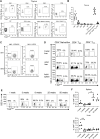A population of naive-like CD4+ T cells stably polarized to the TH 1 lineage
- PMID: 35092032
- PMCID: PMC9304323
- DOI: 10.1002/eji.202149228
A population of naive-like CD4+ T cells stably polarized to the TH 1 lineage
Abstract
T-bet is the lineage-specifying transcription factor for CD4+ TH 1 cells. T-bet has also been found in other CD4+ T cell subsets, including TH 17 cells and Treg, where it modulates their functional characteristics. However, we lack information on when and where T-bet is expressed during T cell differentiation and how this impacts T cell differentiation and function. To address this, we traced the ontogeny of T-bet-expressing cells using a fluorescent fate-mapping mouse line. We demonstrate that T-bet is expressed in a subset of CD4+ T cells that have naïve cell surface markers and transcriptional profile and that this novel cell population is phenotypically and functionally distinct from previously described populations of naïve and memory CD4+ T cells. Naïve-like T-bet-experienced cells are polarized to the TH 1 lineage, predisposed to produce IFN-γ upon cell activation, and resist repolarization to other lineages in vitro and in vivo. These results demonstrate that lineage-specifying factors can polarize T cells in the absence of canonical markers of T cell activation and that this has an impact on the subsequent T-helper response.
Keywords: CD4 T cells; Gene regulation; IFNg; Immune regulation; T cells; T helper cells; T-bet; TH1; Transgenic models; colitis; mouse model; naive T cells.
© 2022 The Authors. European Journal of Immunology published by Wiley-VCH GmbH.
Conflict of interest statement
The authors declare that there is no conflict of interest.
Figures





References
-
- Mosmann, T. R. , Cherwinski, H. , Bond, M. W. , Giedlin, M. A. and Coffman, R. L. , Two types of murine helper T cell clone. I. Definition according to profiles of lymphokine activities and secreted proteins. J. Immunol. 1986. 136: 2348. - PubMed
-
- Szabo, S. J. , Kim, S. T. , Costa, G. L. , Zhang, X. , Fathman, C. G. and Glimcher, L. H. , A novel transcription factor, T‐bet, directs Th1 lineage commitment. Cell 2000. 100: 655–669. - PubMed
-
- Jenner, R. G. , Townsend, M. J. , Jackson, I. , Sun, K. , Bouwman, R. D. , Young, R. A. , Glimcher, L. H. and Lord, G. M. , The transcription factors T‐bet and GATA‐3 control alternative pathways of T‐cell differentiation through a shared set of target genes. Proc. Natl. Acad. Sci. 2009. 106: 17876. - PMC - PubMed
MeSH terms
Substances
Grants and funding
- MC_PC_14105/MRC_/Medical Research Council/United Kingdom
- C416/A25145/CRUK_/Cancer Research UK/United Kingdom
- MR/W002337/1/MRC_/Medical Research Council/United Kingdom
- WT101159/WT_/Wellcome Trust/United Kingdom
- DH_/Department of Health/United Kingdom
- MR/R024812/1/MRC_/Medical Research Council/United Kingdom
- MR/K002996/1/MRC_/Medical Research Council/United Kingdom
- WT_/Wellcome Trust/United Kingdom
- MR/W018748/1/MRC_/Medical Research Council/United Kingdom
- MR/M003493/1 /MRC_/Medical Research Council/United Kingdom
- MR/M003493/1/MRC_/Medical Research Council/United Kingdom
- MR/R001413/1/MRC_/Medical Research Council/United Kingdom
LinkOut - more resources
Full Text Sources
Molecular Biology Databases
Research Materials

